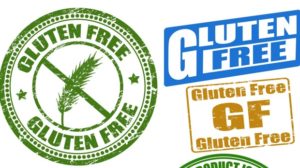If you have a gluten free diet and have shopped for gluten free foods, perhaps you have been confused by the many variations in the gluten free label. The labeling is regulated by the Food and Drug Administration (FDA) for most foods except meat and eggs, which are regulated by the United States Department of Agriculture (USDA).
 Celiac disease experts have determined that less than 20 parts per million (ppm) is a safe amount for most people with Celiac disease. The FDA established a gluten limit(PDF) of less than 20 ppm for foods labeled with one of these four terms: gluten free, free of gluten, no gluten and without gluten. However, the regulations don’t require manufacturers to use a specific location or logo in placing a “gluten-free” claim on the food label. You might also see a logo of a gluten-free certification program (such as ‘Certified Gluten Free’) on food labels. This means the manufacturer has hired a third-party to test and certify that the food is gluten free. The FDA does not endorse or recommend any particular third-party gluten-free certification program.
Celiac disease experts have determined that less than 20 parts per million (ppm) is a safe amount for most people with Celiac disease. The FDA established a gluten limit(PDF) of less than 20 ppm for foods labeled with one of these four terms: gluten free, free of gluten, no gluten and without gluten. However, the regulations don’t require manufacturers to use a specific location or logo in placing a “gluten-free” claim on the food label. You might also see a logo of a gluten-free certification program (such as ‘Certified Gluten Free’) on food labels. This means the manufacturer has hired a third-party to test and certify that the food is gluten free. The FDA does not endorse or recommend any particular third-party gluten-free certification program.
While the FDA has regulations in place to safeguard food from allergens and limit consumer misperception, confusion still abounds. There are a variety of ambiguous labeling terms such as “no gluten ingredients” and “made without gluten.” The gluten free label is a valuable selling point and these terms do not follow the labeling regulations. When labels are vague, it is a good idea to contact the manufacturer and clarify the gluten free status of the product.
Manufacturers may voluntarily list advisory warnings such as “made on shared equipment” or “made in a shared facility.” The Food Allergen Labeling and Consumer Protection Act of 2004 requires that labels must clearly identify the food source names of all ingredients that are — or contain any protein derived from — the eight most common food allergens: milk, eggs, fish, shellfish, tree nuts, peanuts, wheat and soybeans. Consumers on a gluten free diet must also avoid barley (and malt) as well as rye. These grains are not listed in the major allergens so gluten free consumers need to carefully read all ingredient lists.
The labeling requirements do not apply to the potential presence of major food allergens in foods due to “cross-contact” situations during manufacturing. Cross-contact occurs when a trace amount of an allergenic food comes in contact with another food. Gluten from cross contamination may be enough to cause illness in someone with Celiac disease, wheat allergy or gluten sensitivity.
If you would like more information, please visit this 30 minute webinar by OSU Extension on Gluten Free Eating and stay tuned to Live Smart Ohio for future posts on the Food blog.

